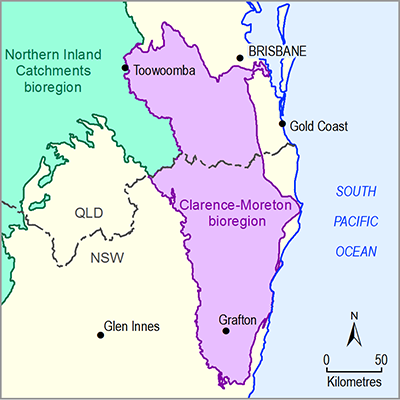Page 29 of 77
CSG exploration wells drilled during the past 10 to 15 years together with newly acquired or reprocessed seismic data help considerably in improving understanding of the geometry of the bedrock stratigraphic units in the Clarence-Moreton bioregion.
Despite the new data, knowledge gaps that will translate into uncertainties on the subsurface stratigraphic architecture represented by the three-dimensional geological model still remain. The gaps and uncertainties will be discussed in more detail as part of companion product 2.3 for the Clarence-Moreton bioregion (Raiber et al., 2016). Major knowledge gaps include:
- lack of shallow bores in the Clarence river basin, meaning that the interface between the alluvial and underlying bedrock aquifers is poorly constrained
- lack of understanding on fault displacements in many parts of the Clarence-Moreton bioregion
- lack of stratigraphic wells and stratigraphic information in groundwater bores in many areas of the bioregion such as the northern part of the Richmond river basin near the border to Queensland
- lack of understanding of the depth of the Clarence-Moreton Basin underneath the Bremer river basin with no well intersecting the top of the basement underneath the Clarence-Moreton Basin
- lack of understanding of the vertical boundaries between different formations underneath the Main Range Volcanics (particularly at the boundary of the Bremer and the Condamine river basins) and the Lamington Volcanics (particularly near the border of Queensland and NSW)
- poor coverage of high-resolution airborne geophysical imagery.
Last updated:
19 October 2018

Summary and download
Product Finalisation date
2016
PRODUCT CONTENTS
- 2.1.1 Geography
- 2.1.2 Geology
- 2.1.2.1 Methods
- 2.1.2.2 Observed data
- 2.1.2.3 Statistical analysis and interpolation
- 2.1.2.3.1 Three-dimensional geological model workflow
- 2.1.2.3.2 Definition of the stratigraphic column
- 2.1.2.3.3 Selection of input datasets
- 2.1.2.3.4 Representation of structural elements in the three-dimensional geological model
- 2.1.2.3.5 Characterisation of binding horizons of shallow aquifers (alluvium and basalt)
- 2.1.2.3.6 Characterisation of the bedrock stratigraphic units in the Clarence-Moreton bioregion
- 2.1.2.3.7 Isopach maps, depth to formation top and depth to base of formation
- 2.1.2.4 Gaps
- References
- Datasets
- 2.1.3 Hydrogeology and groundwater quality
- 2.1.4 Surface water hydrology and water quality
- 2.1.5 Surface water – groundwater interactions
- 2.1.6 Water management for coal resource developments
- Glossary
- Citation
- Acknowledgements
- Contributors to the Technical Programme
- About this technical product
ASSESSMENT
ASSESSMENT COMPONENT
